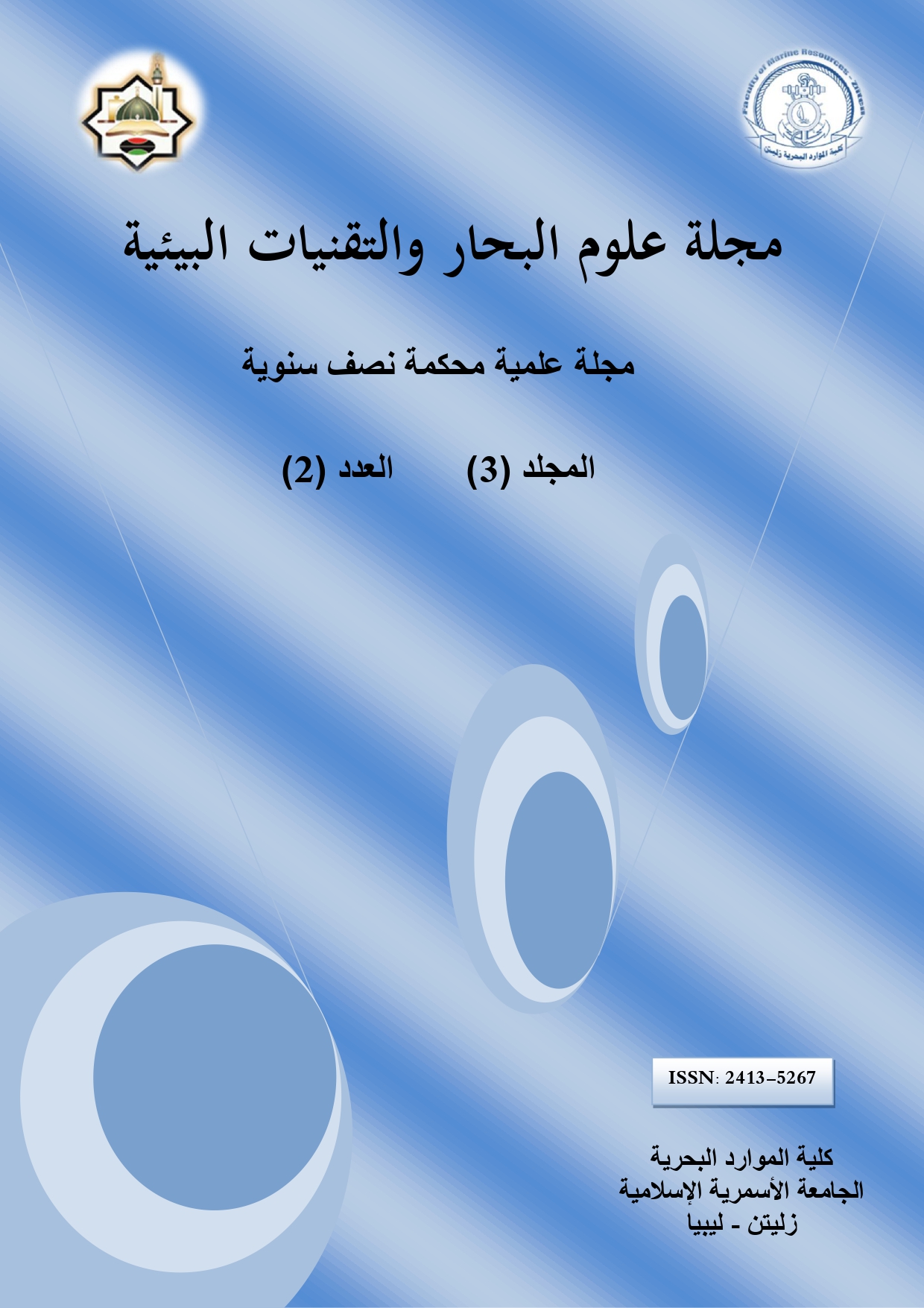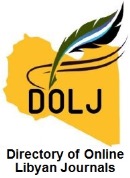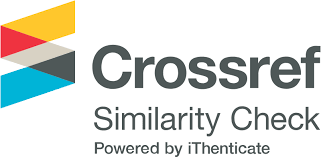دراسة قابلية بكتيريا Bacillus spp. على تثبيط الاغشية الحيوية باستخدام المجهر الالكتروني الماسح
DOI:
https://doi.org/10.59743/jmset.v3i2.96الكلمات المفتاحية:
Bacillus spp، الاغشية الحيوية، المجهر الالكتروني الماسح، الأيوض الثانويةالملخص
عزلت 20 عزلة بكتيرية من عينات مياه وترسبات من مناطق مختلفة من محافظة البصرة جنوب العراق، شخصت العزلات شكليا وكيموحياتياً وباستخدام نظام التشخيص VITEK II compact تبين بانها تعود لأنواع مختلفة للجنس Bacillus كما عزلت 5 عزلات بكتيرية تعود لــــــ5 انواع مكونة للأغشية الحيوية (البكتيريا الهدف)، ثلاث منها موجبة لصبغة غرام هي Kocuria kristinae Staphylococcus sciuri, و Methicillin Resistant Staphylococcus aureus (MRSA),, ونوعين سالبة لصبغة غرام وهما Pseudomonas aeruginosa و Escherichia coli . تم انتاج واستخلاص الأيوض الثانوية من بكتيريا جنس Bacillus واختبرت فعاليتها التثبيطية ضد البكتيريا الهدف حيث كانت فعاليتها التثبيطية ضد البكتيريا الموجبة لصبغة غرام اعلى منها ضد البكتيريا السالبة لصبغة غرام، فصلت مكونات الأيوض الثانوية باستخدام كروماتوغرافيا الطبقة الرقيقة والتي اظهرت ان هذه الأيوض ذات طبيعة ببتيدية حيث اختيرت العزلة التي اظهرت اعلى قيمة لمعدل الجريان Rf وقد سميت BS8، درست قدرة العزلة BS8 على تثبيط الاغشية الحيوية باستخدام المجهر الالكتروني الماسح حيث اظهرت الصور قدرة هذه العزلة على تثبيط تكوين الاغشية الحيوية وكذلك على تمزيق الاغشية الحيوية حديثة التكوين.
التنزيلات
المراجع
Ahmed A., Khan A.K., Anwar A., Ali S.A., and Shah M.R. (2016). Biofilm inhibitory effect of chlorhexidine conjugated gold nanoparticles against Klebsiella pneumoniae. Microbial Pathogenesis, 98: 50–56.
Al-Sarairah H., Al-Zereini W.A., and Tarawneh K. (2015). Antimicrobial activity of secondary metabolites from a soil Bacillus sp. 7BI isolated from South Al-Karak, Jordan. J. J. Biol. Sci., 8(2): 127-132.
Amin M., Rakhisi Z., and Ahmady A.Z. (2015). Isolation and identification of Bacillus species from soil and evaluation of their antibacterial properties. Avicenna Clin. Microb. Infec., 2(1): 1-4.
Cai W., and Arias C.R. (2017). Biofilm formation on aquaculture substrates by selected bacterial fish pathogens. J. Aquatic Animal Health, 29(2): 1-13.
Charlebois A., Jacques M., Boulianne M., and Archambault M. (2017). Tolerance of Clostridium perfringens biofilms to disinfectants commonly used in the food industry. Food Microbiol., 62: 32-38.
Dusane D.H., Pawar V.S., Nancharaiah Y.V., Venugopalan V.P., and Kumar A.R. (2011). Antibiofilm potential of a glycolipid biosurfactant produced by a tropical marine strain of Serratia marcescens. Biofouling, 27: 645- 654.
Dusane D.H., Damari S.R., Nancharaiah Y.V., Ramaiah N., Venugopalan V.P., Kumar A.R., and Zinjarde S.S. (2013). Disruption of microbial Bergy's manual biofilms by an extracellular protein isolated from epibiotic tropical marine strain of Bacillus lechniformis. PLoS One, 8(5): 1-12.
Foulston L., Elsholz K.W., DeFrancesco A.S., and Losick R. (2014). The extracellular matrix of Staphylococcus aureus biofilms comprises Cytoplasmic proteins that associate with the cell surface in response to decreasing pH. MBio., 5(5): e01667- 14.
Halket G., Dinsdale A.E., and Logan N.A.(2010). Evaluation of the VITEK2 BCL card for identification of Bacillus species and other aerobic endospore formers. Letters in appl. Microbiol., 50: 120-126.
Hentzer M., Eberl L., and Givskov M. (2005). Transcriptom analysis of Pseudomonas aeruginosa biofilm development: anaerobic respiration and iron limitation. Biofouling , 2 :37-61.
Kesel S., von Bronk B., Garcia C.F., Gotz A., Lieleg O., and Opitz M. (2017). Matrix composition determines the dimensions of Bacillus subtilis NCIB 3610 biofilm colonies grown on LB agar. RSC. Adv., 7: 31886- 31898.
Khan S.I., Bulmrosen G., Vecchio D., Golberg A., McCormack M.C., Yarmush M.L., Hamblin M.R., and Austen Jr W.G. (2016). Eradication of multidrug resistant Pseudomonas biofilm with pulsed electric fields. Biotechnol. Bioengeneering, 113(3): 643-650.
Logan N.A., and De Vos P. (2015). Bacillaceae. In : Bergy's manual of systematics of Archea and bacteria . Whitman, W.B.(Ed.). John Wiley and Sons, Inc., in association with Bergy's manual Trust. 146 p.
Marhaeni B., Radjasa O.K., Khoeri M.M., Sabdono A., Bengen D.G., and Sudoyo H. (2011). Antifouling activity of bacterial symbionts of seagrasses against marine biofilmforming bacteria. J. Environ. Prot. (Irvine,. Calif)., 02: 1245–1249.
Mohan G., Kumar A., Thangappanpillai T., and Ramasamy B. (2016). Antimicrobial activities of secondary metabolites and phylogenetic study of sponge endosymbiotic bacteria, Bacillus sp. at Agatti Island Lakshadweep Archipelago. Biotechnol. Reports, 11: 44- 52.
Naves P., Del Prado G., Huelves L., Rodriguez V., Ruiz V., Ponte M., and Soriano F. (2010). Effect of human serum albumin, ibuprofen and N- acetyl-l- cysteine against biofilm formation by Escherichia coli strains. J. Hosp. Infect., 76: 165-170.
Parvathi A., Krishna K., Jose J., Joseph N., and Nair S. (2009). Biochemical and molecular characterization of Bacillus pumilus isolated from coastal environment in Cochin, India. Brazillian J. Microbiol., 40: 269- 275.
PHE (Public Health England) (2015). UK standards for microbiology investigation; identification of Bacillus species. Issue No.3, 27p. Available online at [ www.sfam.org.uk].
Pincus D.H. (2011). Microbial identification using the VITEK® 2 bioMérieux system bioMérieux Hazelwood, MO, USA.
Sawale A., Kadam T.A., and Karale M.A. (2014). Antimicrobial activity of secondary metabolites from halophilic Bacillus pumilus sp. Int. J. Current Microbiol. Appl.Sci.,3(6): 506-512.
Sayem S.M.A., Manzo E., Ciavatta L., Tramice A., Cordone A., and Zanfardino A. (2011). Anti-biofilm activity of an exopolysaccharide from a sponge-associated strain of Bacillus licheniformis. Microbial cell Factories,10: 74-83.
Sharon S.F.B., Kalidas S., and Daniel R.R. (2013). Qualitative analysis of antimicrobial compound by high performance thin layer chromatography method. Asian J. Pharm. Clin. Res., 6(4): 117-120.
Sriram M.I., Kalishwaralal K., Deepak V., Gracerosepat R., Srisakthi K., and Gurunathan S. (2011). Biofilm inhibition and antimicrobial action of lipopeptide biosurfactant produced by heavy metal tolerant strain Bacillus cereus NK1. Colloids Surf .B Biointerfaces, 85(2):174-81.
Teasdale M., Liu J., Wallace J., and Rowley D.C. (2009). Secondary metabolites produced by a marine Halobacillus salinus that inhibit quorum sensing controlled phenotypes in Gram-negative bacteria. Appl. Environ. Microbiol., 75(3): 567-572.
Wilson G.S., Raftos D.A., and Nair S.V. (2011). Antimicrobial activity of surface attached marine bacteria in biofilms. Microbiol. Res., 166: 437-448.
Yebra D.M., Kill S., and Dam-Johansen K. (2004). Antifouling technology- past, present and future steps towards efficient and environmentally friendly antifouling coatings. Progress in Organic Coatings, 50(2):75-104.
التنزيلات
منشور
إصدار
القسم
الرخصة
الحقوق الفكرية (c) 2017 مجلة علوم البحار والتقنيات البيئية

هذا العمل مرخص بموجب Creative Commons Attribution 4.0 International License.












